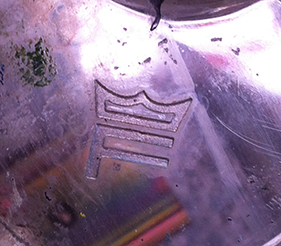Unidentified Italian Press
Hello,
I’ve been trying to identify a press that we have. It looks very distinctive—orange & green—and I know it’s Italian, but beyond that I can find no information. I’ve included a picture of it.
The best I can do to identify it is a well-worn sticker reading “Fonderia Tipografica Cooperativa,” which I know is an Italian typefoundry, but I don’t know if they made presses or not. There’s also a little logo of an F wearing a crown on the plastic circuit board cover. I’ve included pictures of those, too.
I couldn’t find a serial number of any other identifying info anywhere. Does anyone recognize this, or can anyone help identify it?
Thanks!

italian-press.jpg

fonderia.jpg

f-crown.jpg
To possibly help the Armchair Detectives, can it be ascertained if it would accept standard .918 Type High material, or .918 + .050 Standard Galley thickness.?
Would it accept .918 with a *Bed Plate* @ the Metric equivalent.
Does it have the ability, for rise and fall (in opposition) on the impression cylinder & the Ink Train, tracking left to right or Vice Versa.
Does it have *Gripper Fingers* situate and approached from the bottom of the See Through Feedboard.?
In the absence of obvious Data Plate, can a Serial number be found stamped into the *Bed* viewed down hand, very close to either end (of the Bed).?
If it possible for a little more investigation, published as above,! might help solve the enigma.!
The more info you can publish, gives the Archivists, etc more to go on, There are many on B.P. who may even be able to suggest *Back Posts/Archives* Good Luck.
The question of standard type high vs. metric is somewhat puzzling—we’ve tried printing both ways to varying degrees of success. Part of what I’m hoping to figure out by identifying the press is how to best address this.
There are gripper fingers at the right side of the press (in the picture above), and the impression cylinder can be raised/lowered.
I’ll look for a serial number on the bed & report back!
Thanks for your help.
For what it”s worth, Linotype considered Italian type heights as .928” and .977”.
U.D.P. Sorry trying to give you clues to publish for the experts, may have confused the issue.!
Here in U.K. (generally) we see, in smaller form, 2 types of proof press, 1st where the height of the impression roller, runs at type high, (to print) BUT at type height +.050 being the thickness of standard galley, or Bed Plate @ approximately the same thickness, to utilise the full extent of the bed, with type matter straight on to the bed, (and plate) tied up of course, or with powerful magnetic quoins.
If their should be a worthwhile collection of Continental type, @ .928 (with desireable Face to Repro) a bed plate .010 THINNER could and has been used.???
For a good friend, who inherited a substantial font, of a Didot size @ + .010, I locked it up, face down on a Milling machine, and *milled* .010 of off the feet all over, tricky and time consuming, but worked/working well.
2nd. Type of press, (and I have one to sell on eventually).
I.E. The entire carriage, impression cylinder & ink train, are carried on rise and fall Rails, controlled by Micrometer adjustment, hand-wheel, the whole Cranked *Down* to accommodate type matter/image etc, straight on to the bed, or cranked *Up* to accommodate type/image matter on standard Galley, with enough latitude to accommodate type/image etc. on an Antique, “Zinc” galley @ .060 .070, thickness.
Hope my ramblings are clarified, Apologies if not.